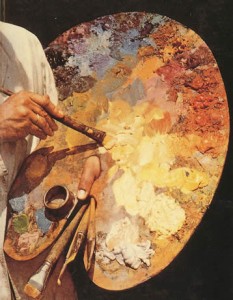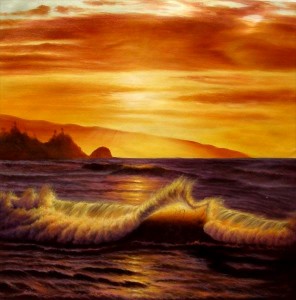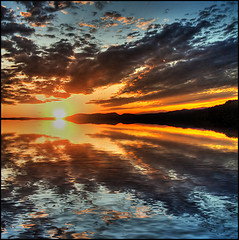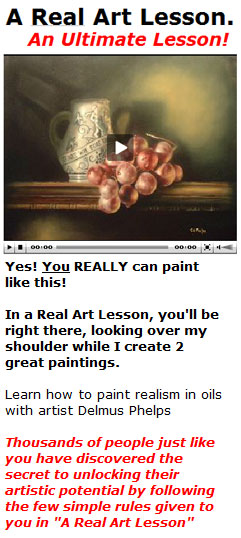Posted by admin | Under Color
Sunday Apr 25, 2010
 The number of different oil colors in any art shop can be staggering. It can also be baffling, because individual ranges may have similar colors under different proprietary names; and it can be off-putting, because the very fact of having so much so easily available may stop you from learning to understand the principles of color and of color mixing.
The number of different oil colors in any art shop can be staggering. It can also be baffling, because individual ranges may have similar colors under different proprietary names; and it can be off-putting, because the very fact of having so much so easily available may stop you from learning to understand the principles of color and of color mixing.
Working outdoors, however, can actually help you to appreciate fine pigments. Our color codes will show you just how much can be produced from only a few basic tubes. You’ll need to take with you the colors listed below.
Oil colors are pigments already mixed with a small amount of oil to help them flow. You can add more oil, or turpentine, to thin out the paint, or white to lighten the effect. Never use white spirit instead of turpentine; made of rectified paraffin, it usually contains impurities that affect some of the colors quite badly. Read the rest of this entry »
Posted by admin | Under Color
Saturday Apr 24, 2010
 One of the great mysteries in painting concerns finding and using a medium. Some artists search and find just what they want. As for myself, I find that I have to change the medium with each picture I am about to paint. If I am going to do a lot of underpainting and glazing, then the medium will have to have properties that suit that final effect. What is proper for glazing does not suffice for alta prima painting.
One of the great mysteries in painting concerns finding and using a medium. Some artists search and find just what they want. As for myself, I find that I have to change the medium with each picture I am about to paint. If I am going to do a lot of underpainting and glazing, then the medium will have to have properties that suit that final effect. What is proper for glazing does not suffice for alta prima painting.
By learning and understanding the many different vehicles and how they will perform, you will build a sound knowledge of their usage. It does not make sense to me to search for a medium that will do all things, such as I dry slow, dry fast, be opaque, be transparent. The artist can from the outset easily select the ingredients for his medium that will do the job for his particular painting. A reliable painting medium, if used with knowledge and used sparingly, should hold up well and cause no bad effects in the future. Read the rest of this entry »
Posted by admin | Under Color
Saturday Apr 24, 2010
 The symphony of color is best revealed to the artist during the hours of sunrise or sunset. At this time of day the colors in the sky and the ocean are at their height. A meadow overlooking the rocks and ocean and cove is a world of its own, a good vantage point. One may spend hours here observing the beauty of the quick-changing sunset with the following after-glow. The sketches for “Late Afternoon” and “Evening” were made here with the companionship of a mild summer breeze, the graceful movements of the grasses and the outcropping of the rocks leading to the ocean below. This evening the ocean is caught in slow motion, its large gentle swells easing into the rocks, playing into the crevices and creating eddies, the spumes splashing skyward, foam in abundance. The war of ocean and rocks has ceased, the evening sky is now advancing to play her melody of color upon the shimmering surface of the earth.
The symphony of color is best revealed to the artist during the hours of sunrise or sunset. At this time of day the colors in the sky and the ocean are at their height. A meadow overlooking the rocks and ocean and cove is a world of its own, a good vantage point. One may spend hours here observing the beauty of the quick-changing sunset with the following after-glow. The sketches for “Late Afternoon” and “Evening” were made here with the companionship of a mild summer breeze, the graceful movements of the grasses and the outcropping of the rocks leading to the ocean below. This evening the ocean is caught in slow motion, its large gentle swells easing into the rocks, playing into the crevices and creating eddies, the spumes splashing skyward, foam in abundance. The war of ocean and rocks has ceased, the evening sky is now advancing to play her melody of color upon the shimmering surface of the earth.
Read the rest of this entry »
Posted by admin | Under Color
Saturday Apr 24, 2010
 The painting of nature is the painting of change and movement, and the artist should always be on the alert to study cause and effect. Color has movement. Relative to the painting of the ocean, it is pure abstract. Perhaps this is best revealed by dipping a bucket of water from any part of the open ocean; it has no color, but is transparent. From the outset you must come to understand that the ocean is a great liquid mirror reflecting to the artist things that play across its surface. At times the mirror breaks, allowing you to peer into the great light-absorbing depths of the ocean. Other times, it lets light strike the bottom and reflect to the surface.
The painting of nature is the painting of change and movement, and the artist should always be on the alert to study cause and effect. Color has movement. Relative to the painting of the ocean, it is pure abstract. Perhaps this is best revealed by dipping a bucket of water from any part of the open ocean; it has no color, but is transparent. From the outset you must come to understand that the ocean is a great liquid mirror reflecting to the artist things that play across its surface. At times the mirror breaks, allowing you to peer into the great light-absorbing depths of the ocean. Other times, it lets light strike the bottom and reflect to the surface.
The fishing folk of the world use this knowledge, especially in the tropics where the white sands and coral reflect large amounts of light, revealing different shades and hues of color, determining for the fisherman the depth of the water for his safe passage. In actuality, the colors in the foreground of a painting from shore may be the same as the colors on the horizon, but are not revealed to us as the same. We are the stationary ones. The light and colors are moving through layers of atmosphere which restrict their and colors are moving through layers of atmosphere which restrict their tones and intensities-they reach the viewer sapped of strength and changed in character. Along with the usual dark-to-light value changes as you recede into your canvas, you must create the illusion of great depth by adding these color changes. Read the rest of this entry »
 The number of different oil colors in any art shop can be staggering. It can also be baffling, because individual ranges may have similar colors under different proprietary names; and it can be off-putting, because the very fact of having so much so easily available may stop you from learning to understand the principles of color and of color mixing.
The number of different oil colors in any art shop can be staggering. It can also be baffling, because individual ranges may have similar colors under different proprietary names; and it can be off-putting, because the very fact of having so much so easily available may stop you from learning to understand the principles of color and of color mixing. One of the great mysteries in painting concerns finding and using a medium. Some artists search and find just what they want. As for myself, I find that I have to change the medium with each picture I am about to paint. If I am going to do a lot of underpainting and glazing, then the medium will have to have properties that suit that final effect. What is proper for glazing does not suffice for alta prima painting.
One of the great mysteries in painting concerns finding and using a medium. Some artists search and find just what they want. As for myself, I find that I have to change the medium with each picture I am about to paint. If I am going to do a lot of underpainting and glazing, then the medium will have to have properties that suit that final effect. What is proper for glazing does not suffice for alta prima painting. The symphony of color is best revealed to the artist during the hours of sunrise or sunset. At this time of day the colors in the sky and the ocean are at their height. A meadow overlooking the rocks and ocean and cove is a world of its own, a good vantage point. One may spend hours here observing the beauty of the quick-changing sunset with the following after-glow. The sketches for “Late Afternoon” and “Evening” were made here with the companionship of a mild summer breeze, the graceful movements of the grasses and the outcropping of the rocks leading to the ocean below. This evening the ocean is caught in slow motion, its large gentle swells easing into the rocks, playing into the crevices and creating eddies, the spumes splashing skyward, foam in abundance. The war of ocean and rocks has ceased, the evening sky is now advancing to play her melody of color upon the shimmering surface of the earth.
The symphony of color is best revealed to the artist during the hours of sunrise or sunset. At this time of day the colors in the sky and the ocean are at their height. A meadow overlooking the rocks and ocean and cove is a world of its own, a good vantage point. One may spend hours here observing the beauty of the quick-changing sunset with the following after-glow. The sketches for “Late Afternoon” and “Evening” were made here with the companionship of a mild summer breeze, the graceful movements of the grasses and the outcropping of the rocks leading to the ocean below. This evening the ocean is caught in slow motion, its large gentle swells easing into the rocks, playing into the crevices and creating eddies, the spumes splashing skyward, foam in abundance. The war of ocean and rocks has ceased, the evening sky is now advancing to play her melody of color upon the shimmering surface of the earth. The painting of nature is the painting of change and movement, and the artist should always be on the alert to study cause and effect. Color has movement. Relative to the painting of the ocean, it is pure abstract. Perhaps this is best revealed by dipping a bucket of water from any part of the open ocean; it has no color, but is transparent. From the outset you must come to understand that the ocean is a great liquid mirror reflecting to the artist things that play across its surface. At times the mirror breaks, allowing you to peer into the great light-absorbing depths of the ocean. Other times, it lets light strike the bottom and reflect to the surface.
The painting of nature is the painting of change and movement, and the artist should always be on the alert to study cause and effect. Color has movement. Relative to the painting of the ocean, it is pure abstract. Perhaps this is best revealed by dipping a bucket of water from any part of the open ocean; it has no color, but is transparent. From the outset you must come to understand that the ocean is a great liquid mirror reflecting to the artist things that play across its surface. At times the mirror breaks, allowing you to peer into the great light-absorbing depths of the ocean. Other times, it lets light strike the bottom and reflect to the surface.